Omis Bridge Soon to Reach Final Phase, Completing the Impressive Project
January 7, 2023 - After the magnificent feat of modern infrastructure that is the Peljesac bridge, Croatia is soon to join another two pieces of its land with a new impressive, incredibly complex construction, the Omis Bridge, hanging 70 metres above this beautiful karst river Cetina.
As Slobodna Dalmacija writes, at the end of January, we will witness the historic joining of the most impressive bridge over the Cetina river; at 70 metres above sea level, the two ends of the bridge that now "stick out" from the gorge. It will connect the portals of the access tunnels "Omis" and "Komorjak."
The last "push" of the bridge section, 12 metres long, is still missing. The section will complete the crossing over the canyon of the karst beauty above Omis, in a visible length of 152 meters, while 30 meters of supports on both sides are "hidden" in the tunnels.
"On the Cetina bridge, there is only one section left of about 12 metres. The last push is expected at the end of January", Hrvatske Ceste (HC) revealed. They are the investor for the Omis bypass, as part of which the bridge is being built, all so that soon we can finally utilise the long-awaited fast, modern road Split-Omis.
Slobodna Dalmacija was curious and asked the investors why the parts of the bridge are not at the same height, because the difference of almost two metres between the eastern and western parts is visible to the naked eye, even from a greater distance.
"It is true that the currently constructed parts of the Omis bridge are not at the same height. Due to the variable height of the cross-section of the bridge, the structure also moves vertically during each push.
After the final phase, both sides will be at the same height so that they can be connected and the entire structure can finally be fixed on the bearings," Hrvatske Ceste specified.
For more, make sure to check out our dedicated Travel section.
Five Freshwater Destinations in Croatia for a Summer Dip
May 29, 2022 - While it may sound silly not to take advantage of the summer to enjoy the Adriatic Sea to the fullest, this time of year is ideal for visiting other destinations beyond the coast. In case you are far from the sea and need to take a dip, here are some freshwater destinations in Croatia to cool off!
Summer in Croatia is synonymous with turquoise waters, paradise islands, and sailboats. For many, if your vacation does not include any of these, then you are not enjoying the country as you should. I do not agree. Although visiting the Adriatic is essential, summer brings with it a wide variety of opportunities throughout the entire geography of Croatia. The parks and fields are filled with green and shade, perfect for hiding from the sun. Also, the number of events and festivities multiply considerably in central and eastern Croatia. Why would you miss any of this?
If you can, including central and eastern Croatia in your travel itinerary is a great idea. Zagreb and Osijek airports will also increase their routes and flights throughout, and after getting to know both cities and their surroundings, you can head to see what makes Croatia so famous: its coast and islands. But don't worry, we know that these regions of the country are no strangers to high temperatures, and you will surely want to take a dip before waiting to travel to the coast. If freshwater is also your thing, here are some non-beach destinations in Croatia where you can cool off.
Jarun lake, Zagreb
When temperatures rise to an unbearable point at this time of year, Lake Jarun becomes a haven of shade and fresh water for the inhabitants of the Croatian capital. Jarun Lake is a 2 km artificial body of water, surrounded by cycling paths, promenades, forests, and parks. It was built and opened in 1987 for the Universiade - World University Games. The lake is ideal not only for bathers, but for all those who practice activities such as rowing, kayaking, or paddling.

Jarun lake. (Image: Croatian National Tourist Board)
Drava river, Osijek
The Drava, the main river in Osijek, gives the city not only a beautiful appeal but also offers its inhabitants an ideal alternative when summer arrives and the Adriatic is so far away. One would think that it is the custom of only a few, but the banks of the Drava are filled with hundreds of people looking for a good dip even on weekdays. In addition to lying down to sunbathe, family and friends gather to play on the shores and have a picnic.

Drava river, Osijek. (Photo: Mario Romulić)
Foginovo kupalište, Karlovac
Foginovo kupalište is a river bathing area in the city of Karlovac, where its inhabitants cool off in the waters of the Korana river. From its source in Plitvice, the Korana river reaches Karlovac, offering for centuries an oasis of peace, nature, and freshwater to locals and visitors. Bathers enjoy not only fairly clean waters but can also do so in peace thanks to the lifeguards always nearby. It is definitely an ideal destination for everyone, as adults can sunbathe on the shores, while the younger ones enjoy the inflatables and the diving tower.
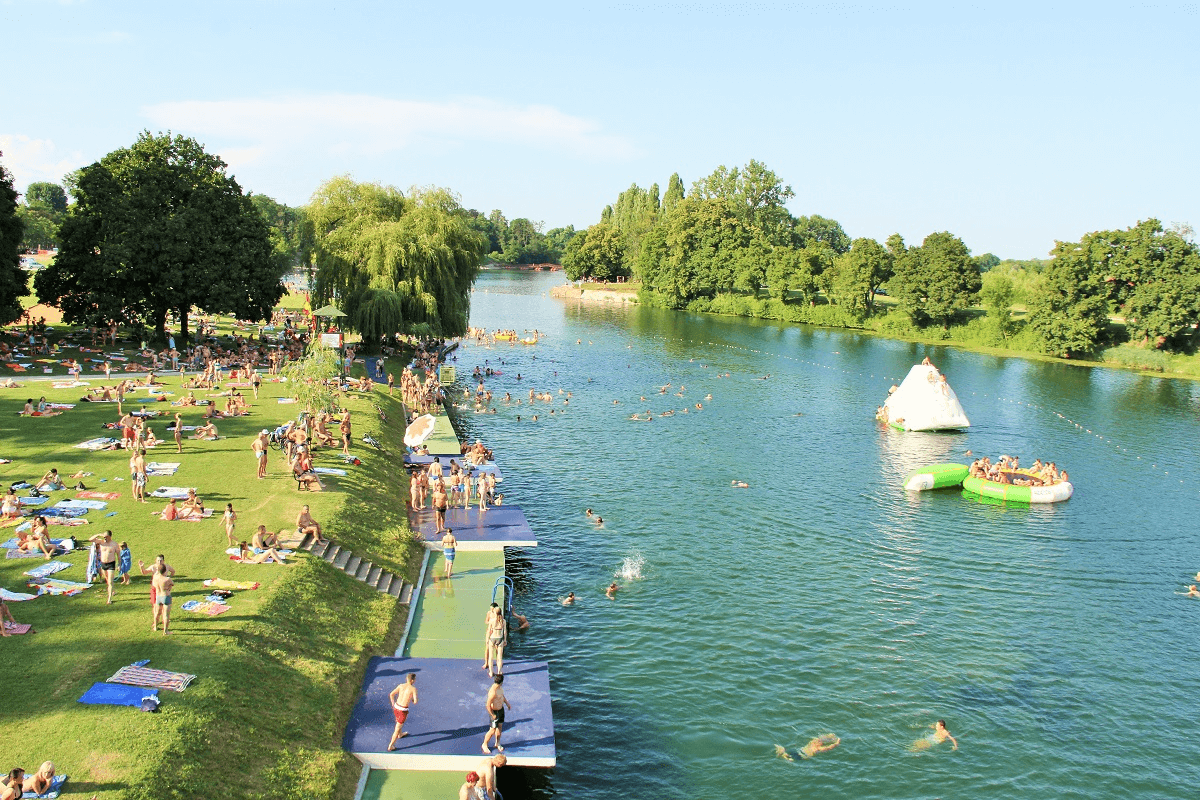
Foginovo kupalište, Karlovac. (Image: Zelenilo.hr)
Cetina river
The Cetina river is one of the largest and most important rivers in southern Croatia, rising from the Cetina spring to the east in Šibenik-Knin County, running through almost all of Dalmatia, and reaching the Adriatic Sea at Omiš. There are those who find the Cetina spring itself an ideal spot for a summer dip, but the entire river has numerous points to cool off. If you are in Omiš, encourage yourself to participate in activities such as kayaking, canoeing, or rafting, as many of the organizers include moments during the tours to take a good bath in freshwater after a good exercise.
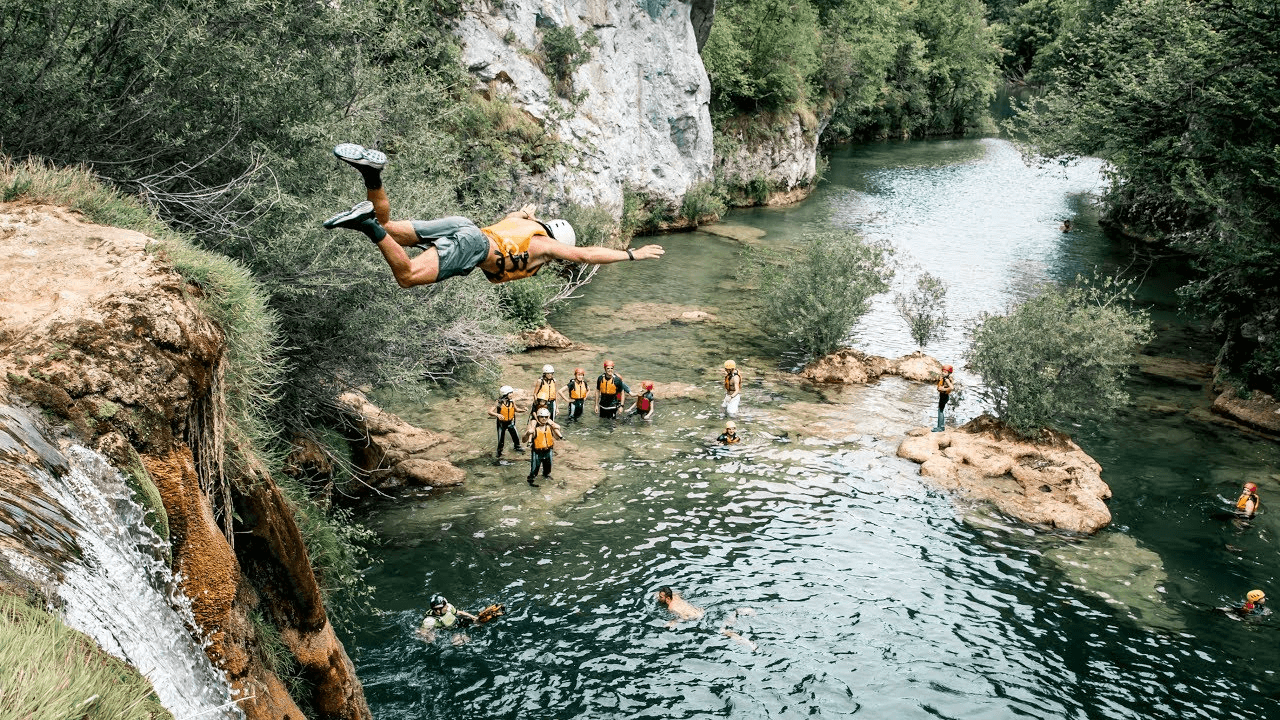
Cetina river. (Image: Mish and Kirk/YouTube Screenshot)
Modro jezero, Imotski
In Imotski, just an hour from Split by car, you will find not only a historic and quite picturesque town but also a group of lakes that are well-known in the country. One, in particular, Modro jezero, is an ideal bathing spot where high temperatures can easily be reached in these months of the year. Of all the alternatives mentioned above, Modro Jezero must be one of the most spectacular in terms of its location and scenery.
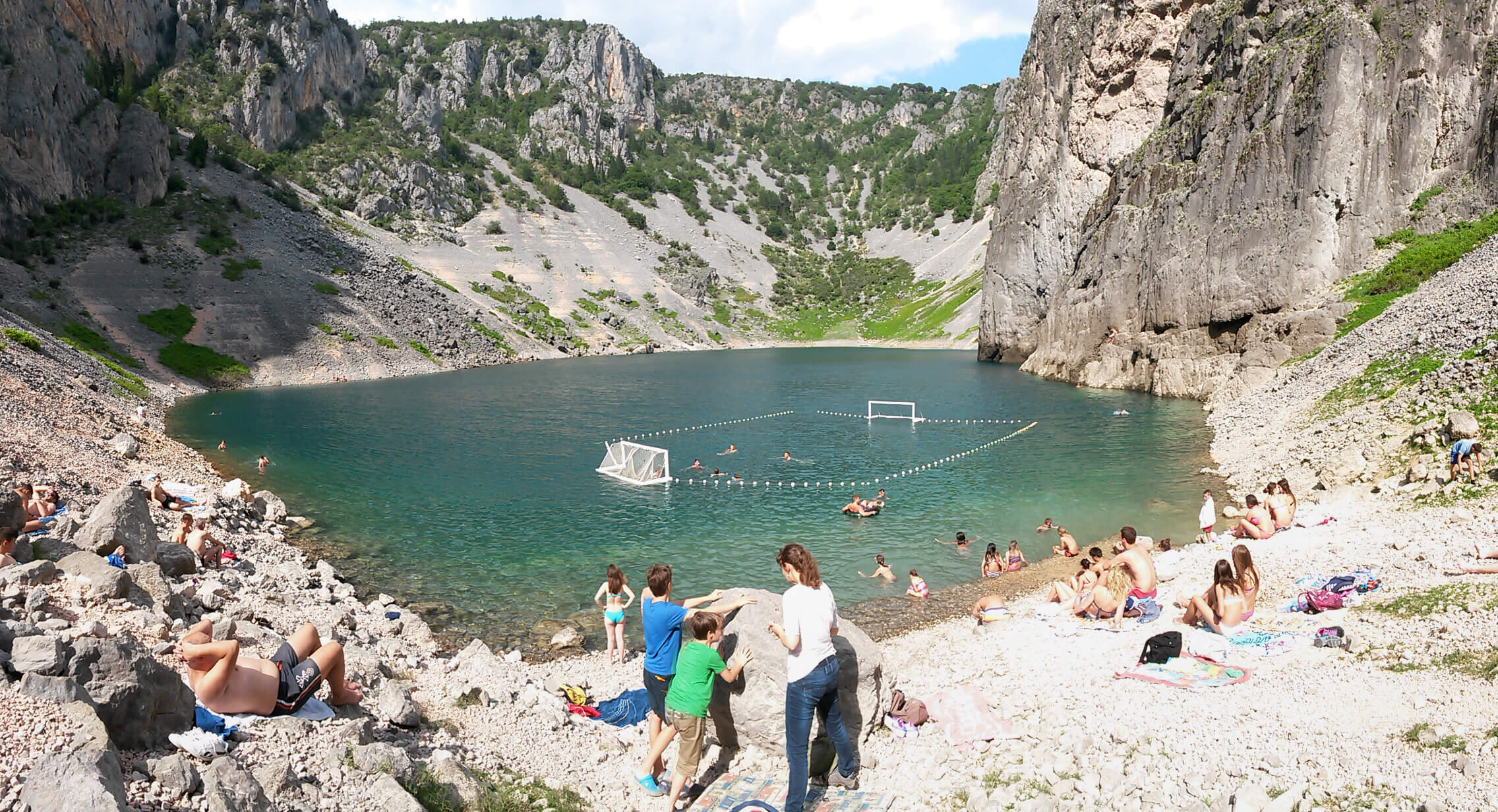
Modro jezero, Imotski. (Photo: Peter Malovrh/Flickr)
For more on travel in Croatia, follow TCN's dedicated page.
Cetina River Basin Being Explored Owing to Energy Potential
April the 7th, 2022 - The Cetina river basin is being explored for its potential energy properties as alternative energy sources are sought following the Russian invasion of Ukraine.
As Poslovni Dnevnik writes, Russia's invasion of neighbouring Ukraine has caused a sharp rise in energy prices from fossil sources, and consequently others. The current situation and trends here in Croatia once again work to remind us of the short-sightedness of the Croatian authorities when it comes to the country's national energy policy, reports Slobodna Dalmacija.
Over more recent years, HEP's new production facilities have been reduced to power plants in Zagreb and Osijek and only one hydropower plant with a capacity of about 40 megawatts, and only today is HEP entering wind and solar power projects without state incentives because, according to the public statements of its main people, even without incentives the production of electricity from wind and solar is economically viable, ie profitable.
In such circumstances, one should look with great optimism at the possible construction of new high-power hydropower plants, such as the potential ones on the Cetina river basin in Otok and in Bitelic.
As things stand today, the resources provided by the wind and the sun are huge and are only just beginning to be used. It is very likely, especially due to the proclaimed anti-fossil energy policy, that the amount of energy produced from these sources here in Croatia will grow steadily. Therefore, it will be necessary to provide in parallel current reserves capable of rescuing the system when unsustainable sources do end up failing.
As such, it isn't really questionable whether the ideas on the construction of reversible hydropower plants (RHE) called 'Blaca' (in Otok) and 'Vrdovo' (in Hrvace), which have long outgrown the idea in operationalisation, will be realised, but for now, the only unknown is just when it will happen.
Locals reacted with displeasure to the recently kicked off HEP geomechanical testing of the soil along the Cetina river basin, more precisely near the village of Gale, where the lower pool of the (as yet) imaginary RHE 'Blaca' would be. HEP's public relations department publicly responded to their understandable protest, stating:
''The Cetina river basin has long since grown into a Croatian hydropower giant. Five hydroelectric power plants are successfully producing electricity on the left side of the river, with a total installed capacity of more than 970 MW, and two future RHE installed electricity factories on the left bank of the Cetina river would exceed a fantastic 2,000 megawatts.
And that, for sure, won't even be the final figure. If in the future the main energy source is wind and solar power, which will be necessary due to the need to substitute Russian natural gas and energy in general from fossil sources, it is certain that new RHEs will be built on the Cetina river basin because there are some extremely favourable natural conditions in that area,'' they stated.
For more, check out our lifestyle section.
Do Summer Showers Impact Microbiological Water Pollution? Omiš Watercare Project Presented
December 11, 2021 - Do heavy summer showers affect the quality of the sea? After extreme rains, there is a slight increase in bacteriological sea pollution. However, these values are so low that Omiš beaches are still within excellent sea quality parameters, reveals the Omiš Watercare project.
Rain greeted the participants of the Omiš Watercare project's final meeting, where the results of the impact of summer showers on microbiological pollution of the Cetina River and the famous Omiš sandy beach were presented.
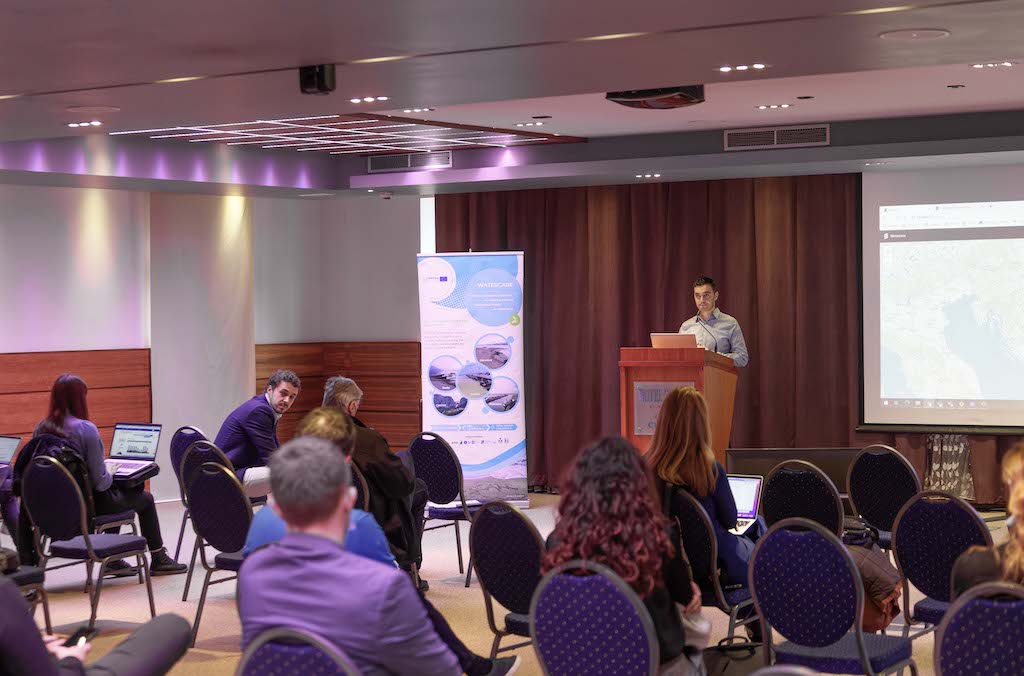
"Cetina is the source of life and economy in much of Dalmatia, from Vrlika to Omiš, all places and cities are connected to the Cetina, and our islands Brač and Hvar depend on it. Therefore, the importance of this river in our lives is indescribable, and that is why we hope that the results of the research are encouraging and that they will give us guidelines for its preservation and protection," said Žarko Kovačić, Deputy Mayor of Omiš, with a warm welcome to the participants.
On behalf of the organizers and partners in the project, Split-Dalmatia County, Anđelko Katavić, Head of the Administrative Department for Economy, EU Funds and Agriculture, explained the complementarity of this with another project implemented by the county on sustainable use of the Cetina River Basin:
"One of the greatest natural resources of our county and state is water, and on the example of the Jadro River, we see how many problems can be caused by more and more frequent showers that increase the parameter of drinking water turbidity. As the name of the project itself says, water should be taken care of, and the knowledge, equipment and instruments we have implemented through the project allow us to react in the event of an emergency as soon as possible."

Generally speaking, the quality of the Split-Dalmatia County sea is excellent; only in some places near rivers and streams is the bathing level lower quality. Martin Bućan, meeting moderator and senior advisor from the Administrative Department for Economy, EU Funds and Agriculture, answered if this is happening at the mouth of the Cetina River.
He explained that automatic water sampling was carried out in the downstream part of the Cetina estuary, using two automatic measuring stations that measured several parameters such as water and air temperature, pressure and humidity, precipitation, wind direction and speed. In addition, specially installed measuring probe water parameters such as salinity, temperature, pH, turbidity, etc., were also examined, including E. coli bacteria and intestinal enterococci in the laboratory. At the same time, at regular intervals from May to October this year, seawater samples were analyzed near the mouth of the Cetina River at six locations in Omiš. Fundamental physicochemical quality indicators and bacteriological indicators, i.e., the presence of E. coli and intestinal enterococci, were also analyzed in seawater samples. Seawater samples were always taken during the morning hours and after completing the sampling of automatic stations. Sampling was carried out in different meteorological conditions, during sunny weather and after heavy rainfall.
“Out of a total of 42 seawater samples collected from six measuring stations after rainy weather, 39 were rated excellent, one sample rated good, while two samples were inconsistent. Therefore, research has shown that there is a slight increase in bacteriological pollution of the sea after extreme rains. However, these values are low on Omiš beaches and still within the parameters of the sea category of excellent quality," concluded Martin Bućan.
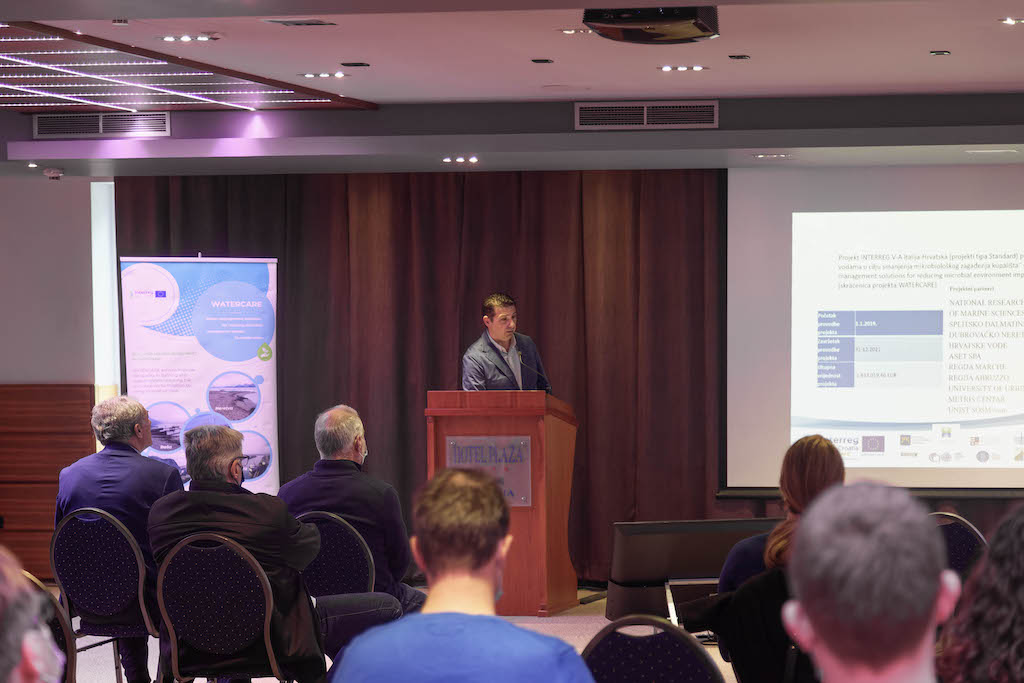
All data obtained from the probes and physical sampling of the sea are transferred to the Watercare project online application, presented by Goran Kopčak from Ericsson Nikola Tesla, an external contractual partner. He explained the functionalities and user interface of the created network application through which numerous stakeholders in the project can access data. Furthermore, thanks to the machine learning concept application, the platform will automatically be able to alert the responsible persons of the County, Civil Protection Headquarters, the City of Omiš, firefighters, and others due to the risk of the increased possibility of bacteriological pollution in the sea.
Once again, the Watercare project confirmed the importance of bringing together all stakeholders with scientific research institutions, which was further argued in their presentation by Marko Mimica and Gina Bilankov from EHCR. They presented a feasibility study to implement innovative solutions of the Cetina River and guidelines for coastal water management following international regulations, as well as the possibility of further financing the developing activities from this project from EU funds.
Water management solutions for reducing microbial environment impact on coastal areas is the full name of the project worth a total of 2.8 million euros, which lasts almost three years and is implemented within the cross-border cooperation program Interreg Italy - Croatia.
To read more about lifestyle in Croatia, follow TCN's dedicated page.
Interesting Legends Behind 4 Popular Tourist Destinations in Croatia
July 28, 2021 - Croatia is mostly visited by tourists because of its long Adriatic coast but it's also blessed with enchanting rivers, lakes, and waterfalls. Not many visitors know that the surreal crystal clear blue and emerald colors of Croatia's different bodies of water are also home to many mysterious mythical creatures, historical heroines, and legendary tales. Get to know the mythical inhabitants of Croatia and explore the world of epic Croatian folklores in 4 popular tourist destinations in Croatia.
Cetina and the Story of Mila
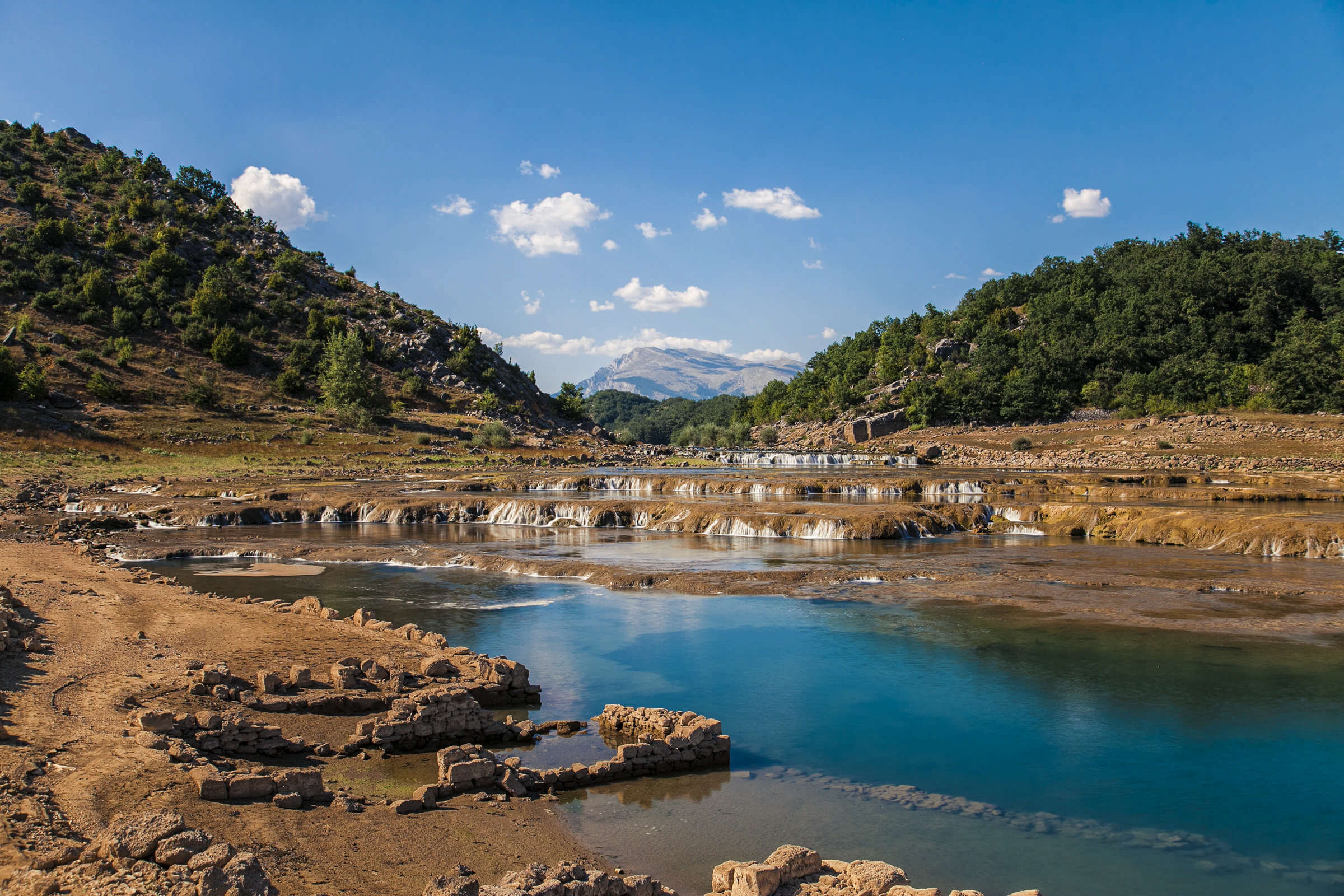 Photo credit: Mario Romulić
Photo credit: Mario Romulić
Gushing under two mountains, the Dinara and Gnjat, and passing through the scenic towns of Sinj, Trilj, Zadvarje, and Omiš where it finally meets the Adriatic Sea, the Cetina River is one of the most beautiful canyons in Croatia and is a famous day trip destination for both locals and tourists. Considered the longest river in Dalmatia with its length of 101km, Cetina is a perfect place for canyoning, zip-lining, freshwater kayaking, and white water rafting. The clear blue water of the Cetina River has been a generous source of clean water and freshwater fish for the people of Dalmatia over the centuries. Thanks to the nymph named Cetina, this beautiful river came to life. According to legend, Cetina desperately dreamed of conceiving a child and was tricked by the sexually ravenous God, Zeus, who promised to bore her an offspring after their union. After many weeks of waiting, Cetina did not get pregnant and upon realizing Zeus' trickery, the heartbroken nymph wept endlessly until her tears formed a river and eventually, the Cetina dried up and turned into stone. The Neolithic people believed that a person who wishes to conceive will be blessed with a baby of good fortune after bathing in the tears of the late demigoddess. There is also another story in Cetina that is historically significant to Croatian people. It is the story of a brave and clever woman who single-handedly defeated a whole Ottoman army - Mila Gojsalić.
In 1530, Ahmed Pasha led a powerful Ottoman army to conquer the Republic of Poljica, now known as the modern-day Omiš. The army terrorised, pillaged, and ravaged the people of this place for a long time, but just before their final attack and Poljica's fall, a young beautiful woman named Mila Gojsalić appeared before the army. According to stories, Mila was very beautiful and her charm easily bewitched Ahmed Pasha who fell right under her spell. Mila pretended to be in love with the leader of the Ottoman army and she ended up sleeping in the leader's tent. That evening, Mila sacrificed her chastity and life for her people. After making sure that Ahmed and his men were asleep, she snuck into the gunpowder storage with a torch and blew up the whole military camp. The powerful blast killed Ahmed Pasha and most of the Ottoman warriors, including the beloved heroine of Poljica. Although some stories claimed that Mila escaped the camp and plunged from the high cliffs down to her death in the river of Cetina.
 Photo credit: By Ivan T. - Own work, CC BY-SA 3.0, https://commons.wikimedia.org/w/index.php?curid=17699310
Photo credit: By Ivan T. - Own work, CC BY-SA 3.0, https://commons.wikimedia.org/w/index.php?curid=17699310
The heroic act of Mila ignited courage from the people of Poljica who began to fought back until every single one of the Ottoman invaders was dead. To honor Mila's sacrifice and bravery, the greatest Croatian sculptor Ivan Meštrović created a statue of her. In the village of Gata, overlooking Cetina and Omiš stands the statue of Mila Gojsalić - a heroine who watches over the people of Omiš day in and day out.
Plitvice Lakes and The Black Queen
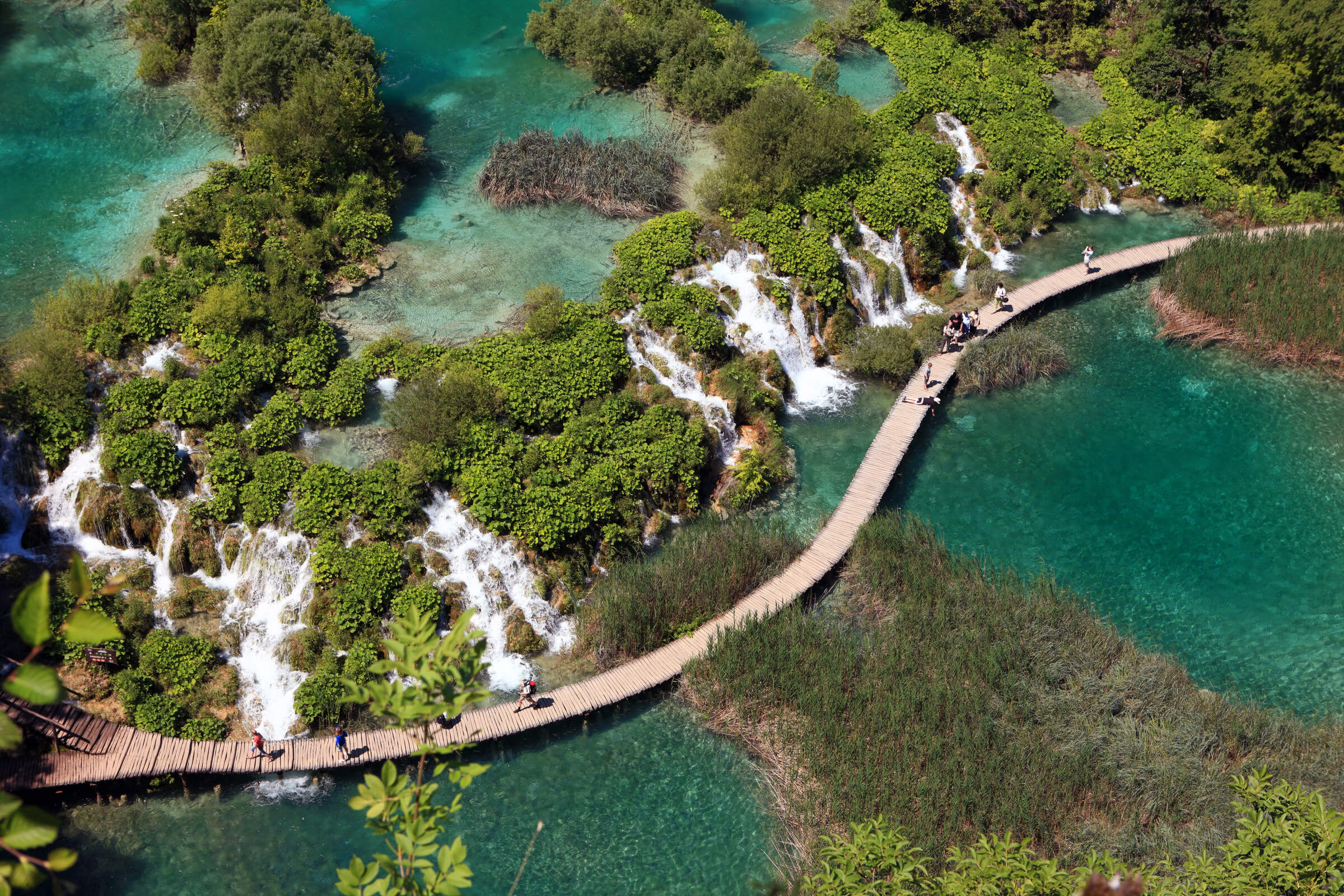 Photo credit: Mario Romulić
Photo credit: Mario Romulić
The Plitvice Lakes National Park is probably the most famous national park in Croatia. Millions of tourists flock to visit this magnificent landscape that is consisted of 16 crystal shades of blue and emerald lakes which are connected by many rivers, streams, caves, and waterfalls and are surrounded by luscious green woodland. This incredible scenery was created by the endless stream of waters that have been flowing over limestones and chalks for thousands of years, until eventually forming natural dams through deposits of travertine barriers. All thanks to nature's wonderful phenomenon, a series of 16 beautiful lakes came to life!
But Croatian folklore, on the other hand, believes that Plitvice Lakes appear magical because it was, indeed, magical. Legend has it that a long time ago, the area of Plitvice only had one source of water - the Black River (Crna Rijeka). Unfortunately, the area was struck with a long-lasting horrible drought which dried out the Black River, and the crops, livestock, and people began dying. In despair, the people prayed and cried all day to the heavens for some rain, but for a very long time, their prayers were left unanswered. They were close to giving up when the Black Queen, who had just left her fairy palace to head to an area near Plitvice, happened to hear their pleas. After witnessing the damage of the drought to the people, the Black Queen said, “I am sad to see that you are suffering!” After that, the winds and thunder started to roar and strong rain came and poured for days and days on end until the Black River overflowed and 13 lakes appeared. People believed that the Black Queen cried for the people's misfortunes and her black and white tears formed the Black River and the White River in Plitvice. Together with the Matica River, they form the first lake and it was named Prošćansko (prošnja = prayer), to commemorate the prayers of the anguished people. For their token of gratitude to the Black Queen, the people of Plitvice built her a castle on the hill above lake Kozjak, where she can admire the splendour of her own creation.
Imotski's Red and Blue Lakes and The Wicked Gavan Family
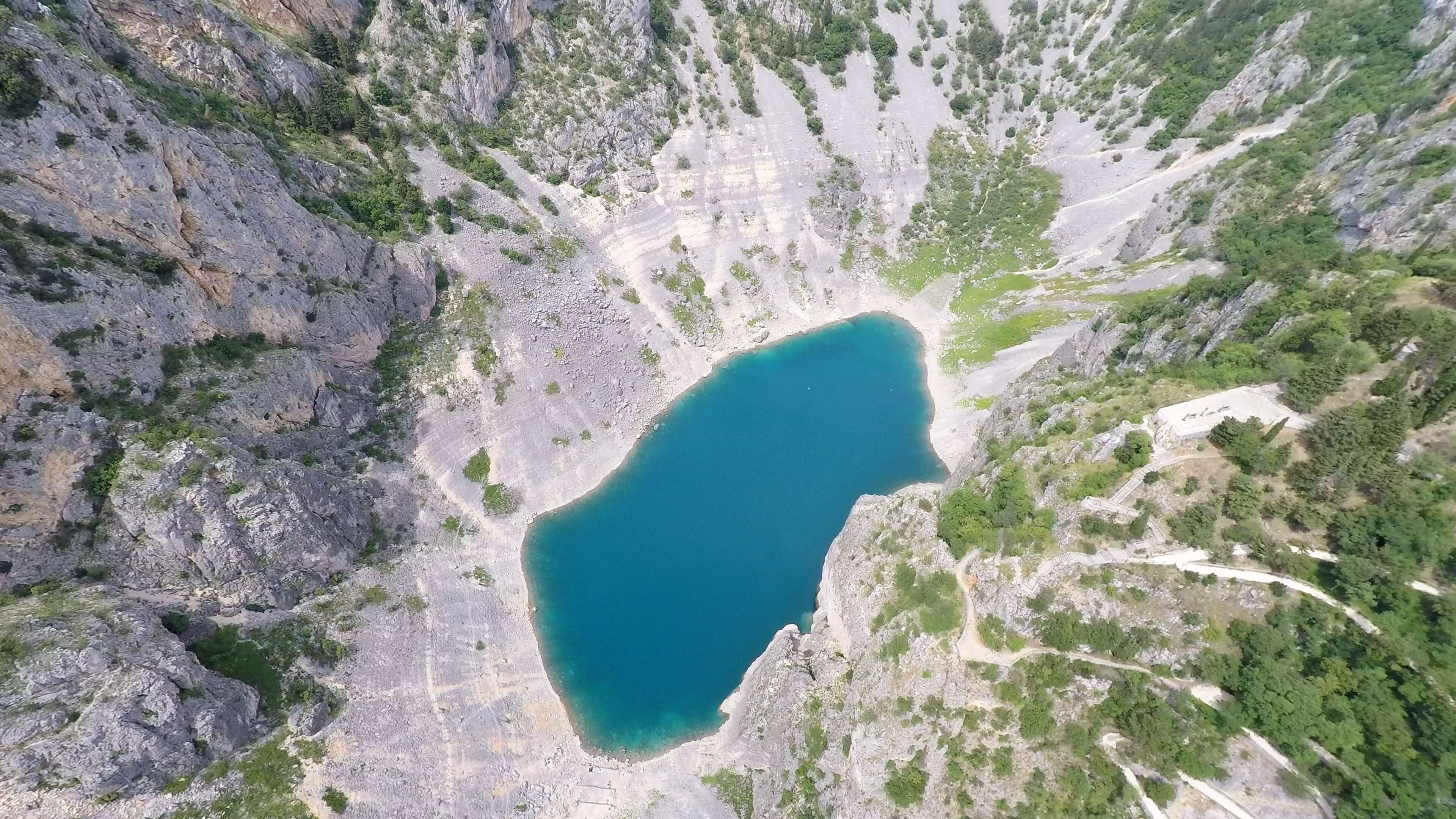 Photo credit: By Yacht Rent from Croatia - modro jezero Croatia, CC BY 2.0, https://commons.wikimedia.org/w/index.php?curid=81974343
Photo credit: By Yacht Rent from Croatia - modro jezero Croatia, CC BY 2.0, https://commons.wikimedia.org/w/index.php?curid=81974343
A small town that is perfect for travellers who wish to steer away from the frenzy of tourists, Imotski is Dalmatia’s hidden gem packed with nature, culture, history, and friendly locals. Unlike the busy coastal cities of Dubrovnik and Split, Imotski possesses a different charm - tucked in the inland region of Dalmatia without the Adriatic Sea, this town, instead, offers an array of unique and breath-taking landscapes to its visitors. Imotski is rigged with incredible karst formations such as hidden caves, sinkholes, karst rivers, lakes, and canyons. The distinctive geographical formations of Imotski inspired countless folk tales including fairies, heroines, and goblins. Perhaps the most famous of these intriguing formations are the Red and Blue Lakes, two magnificent karst lake formations which, according to Croatian folklore, have emerged to swallow the palace and wealth of the wicked Gavan family.
Named after the reddish color of the surrounding cliffs, the Red Lake is a beautiful karst lake and the third largest sinkhole in the world. It can't be reached on foot and without special equipment. Meanwhile, the Blue Lake is easily accessible and is located just beneath the historical Topana Fortress in Imotski. Locals and tourists are welcome to swim in the calm, turquoise blue water of the lake. The stunning and serene blue lake, however, hides a story of the evil Gavan family who used to live in the area of Imotski. According to folklore, Gavan with his wife, Gavanica, and their children, were the wealthiest and most powerful family in Imotski. Nonetheless, the Gavan family was known to be very cruel and vile towards their servants and neighbours and the only thing that mattered to them was their wealth. An angel heard about Gavan’s horrific acts and decided to descend down from heaven to test the Gavan family. The angel disguised as a beggar and knocked on the Gavan's palace door to ask for help. Gavanica opened the door and refused to provide any help to the beggar. The angel then asked Gavanica, “Are you not afraid of God’s punishment?” The arrogant woman replied, “What good can God do for me when I have my Gavan?” It was then that the angel revealed his disguise and punished the Gavan family. It was believed that the ground where the Gavan’s palace stood cracked open and swallowed the Gavans and their entire wealth. The locals still believe that the deep hole, now covered by the Red and Blue Lakes, still contain the palace and wealth of the family and on windy days when the bora wind blows, the screams of Gavan and Gavanica can still be heard around the area of these lakes. The locals also claim that beautiful fairies who live in the Fairy Cave in the Blue Lake have been sighted basking in the beauty of the lake at sunset and dawn. There is a current rumor that no human has ever managed to set foot on the Fairy Cave.
Stories of fairies and foes aside, the Blue Lake transforms into a spectacular football field every few years when it dries up. Many people flock to Imotski to witness these rare and out-of-this-world football matches on Imotski’s mysterious lakebed.
Krka National Park and The Tragic Love Story of Bogdan and Miljeva
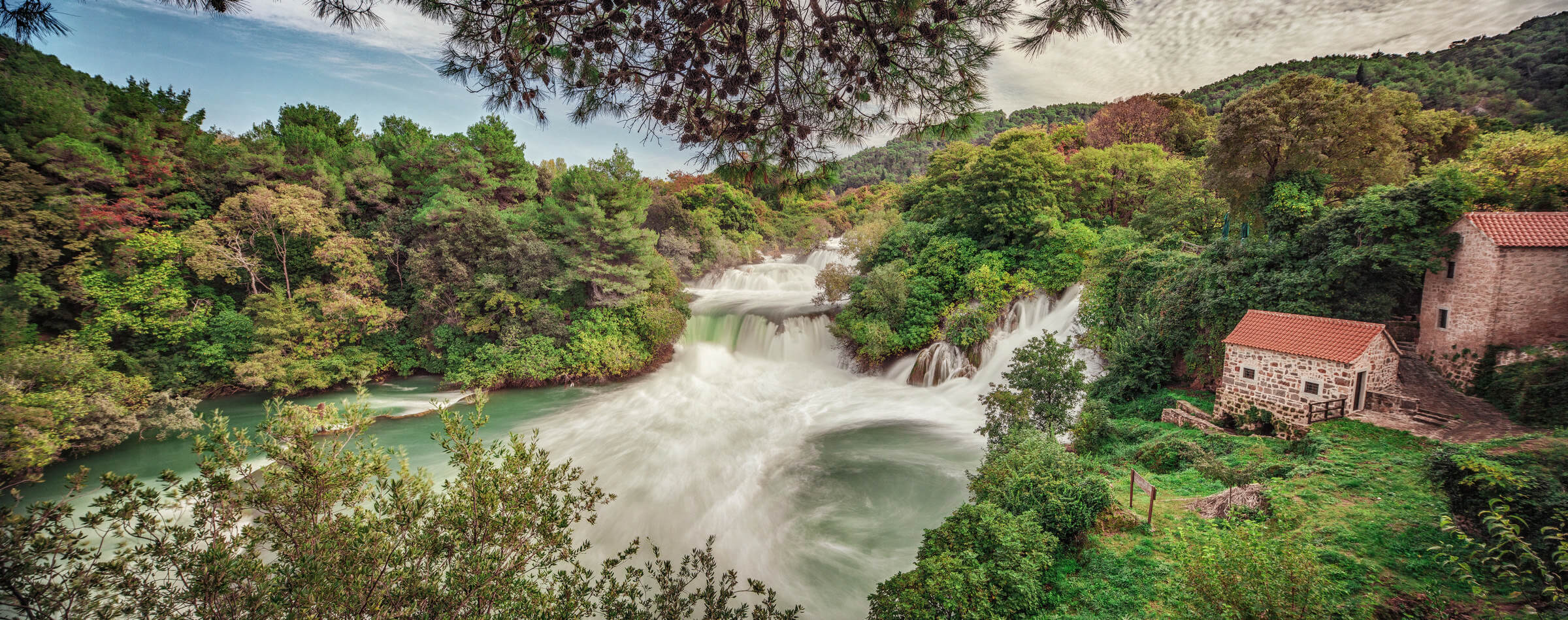 Photo credit: Mario Romulić
Photo credit: Mario Romulić
One of the most visited national parks in Croatia, Krka National Park has it all - the iconic Skradinski Buk waterfall, Neolithic cave, Roman architecture remains, Krka Monastery and so much more! It is also very accessible especially if you are coming from the coastal cities of Split and Šibenik. The park which is filled with dazzling waterfalls, gorges, and the 73km-long Krka river that gushes through a karstic canyon of 200m deep are intertwined by walking paths, hiking trails, and wooden bridges. The park has five main entrances: Skradin, Lozovac, Roški Slap, Krka Monastery, and Burnum, and all are accessible by car. But before becoming Dalmatia’s most famous tourist attraction, Krka National Park is built from the tragic love story of Bogdan and Miljeva.
A long time ago, the mighty Prince Bogoje lived in the area of Krka. In Bogočin, he built a beautiful palace for his son, Bogdan, who was set to marry a lovely noblewoman who lives in the town of Ključ across the river Čikola. That woman’s name was Miljeva and she was the daughter of influential Ban Domagoj and his wife Čika. Bogdan and Miljeva were cherished by the townspeople and on their wedding day, a large gathering of seven bans and twelve county prefects have gathered in Bogočin to witness the union of the beloved couple. The wedding was a success and everyone headed to the palace to celebrate the newlyweds where a tragic fate awaited the couple. During the celebration, a terrifying dragon descended into the party and dragged Princess Miljeva to the bottom of Lake Brljan. Prince Bogdan came to rescue his bride but the beast drew him to the river of Krka as well. This tragedy broke the heart of Prince Bogoje who used up all his wealth to grieve the loss of his son and Miljeva. With his riches, he built Aranđelovac monastery, a place to pray for the souls of the lovers. He also built the towns of Čučevo and Nečven to symbolize the love between Bogdan and Miljeva. In addition, he built two bridges which connect Roški waterfall and river Miljacka. Local folks believed that anyone who wishes to cross the bridges has to shed two tears to pay homage to the tragic fate of Bogdan and Miljeva's love. In the end, Prince Bogoje tore down the Bogočin palace and set off from this grief-stricken town into the unknown. Meanwhile, Miljeva’s mother, Čika, secluded herself to pray for the late lovers in a tower she built in Ključ.
Because of this tragic love story, Bogočin is known by the locals as a “fairy town”, the river near Ključ is named Čikola and the area between Bogočin and Ključ is called Miljevci.
For more on Croatia's top travel destinations, follow Total Croatia.
For more on travel, follow TCN's dedicated page.
For more about Croatia, CLICK HERE.
Visit Omis: The Summertime Holiday Winter Dreams Are Made For
17 December 2020 – Missing adventure, escape, breathtaking landscapes and unspoiled nature? Visit Omis in 2021 - with 20 kilometres of perfect beaches and crystal-clear seas, the mighty Cetina river and an atmospheric Old Town, it's the summertime holiday that winter dreams are made for.
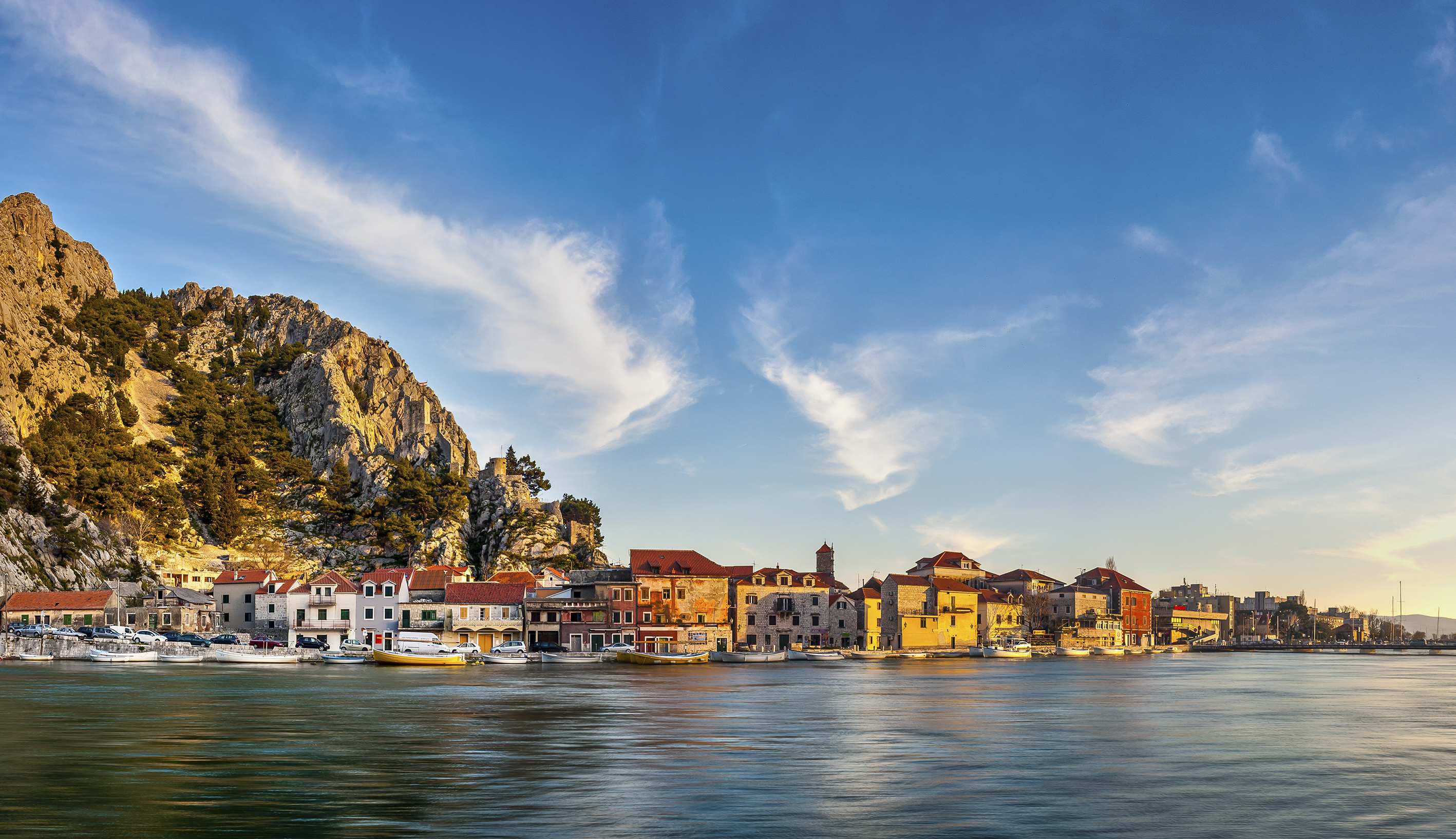 The pretty pastel shades of buildings in Omis contrast beautifully against the sheer, grey, karst rock which rises sharply behind © Omis Tourist Board
The pretty pastel shades of buildings in Omis contrast beautifully against the sheer, grey, karst rock which rises sharply behind © Omis Tourist Board
The cold outside is often reason enough to spend most of winter indoors. It's a good time for wrapping presents or even wrapping yourself in blankets. Perhaps, if it snows, you'll sit by the window, daydreaming. With a chill in the air, there's no better dream than that of next summer. In the warmth of the summer sun, you can forget all about those blankets and staying indoors. It's time for escape, adventure, the great outdoors, to hit the beach and to swim in the sea.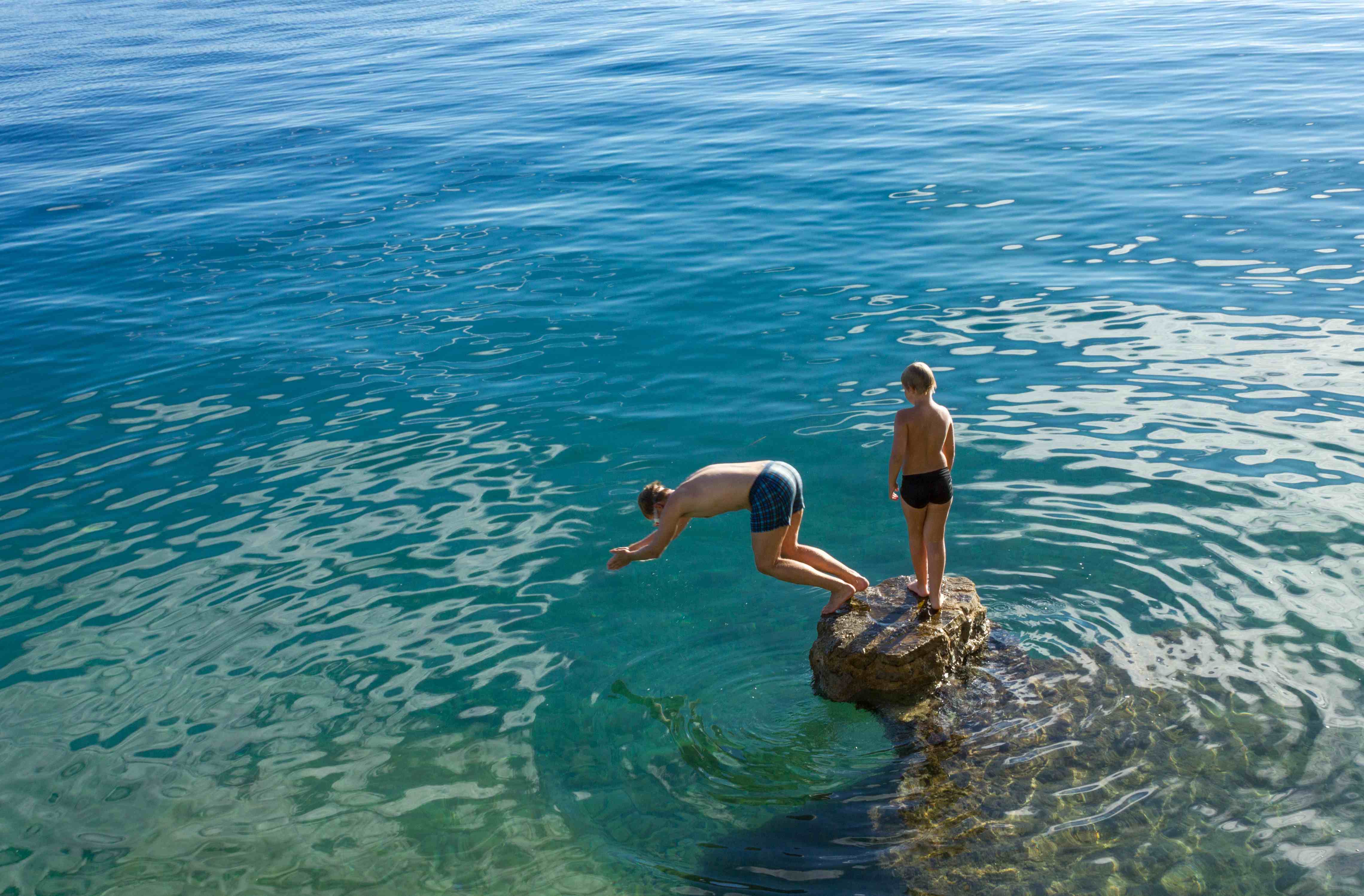 Crystal-clear waters run along the length of the Omis riviera © Omis Tourist Board
Crystal-clear waters run along the length of the Omis riviera © Omis Tourist Board
In 2021, the City of Omis will once again welcome winter's dreamers. From Springtime to October, visitors will come and enjoy its extended summer, many of them returning as they do every year. Because, once you visit Omis, there really is nowhere else that can match its incredible offer. A spectacular landscape, with the lush Cetina river valley cutting through the Dinaric Alps to flow into the sea at Omis - you can see the island of Brac in the distance © Omis Tourist Board
A spectacular landscape, with the lush Cetina river valley cutting through the Dinaric Alps to flow into the sea at Omis - you can see the island of Brac in the distance © Omis Tourist Board
The unique experience when you visit Omis is a product of a singular history and geography. Standing on the mouth of the Cetina - the largest river in Croatia to drain into the Adriatic – Omis and its surrounding riviera is not only filled with pristine and peaceful beaches, it also has waters that, for hundreds of years, have connected the city far into the hinterland. When you visit Omis, it is this riverside positioning that gives its unmissable adventures, culture, heritage and nature.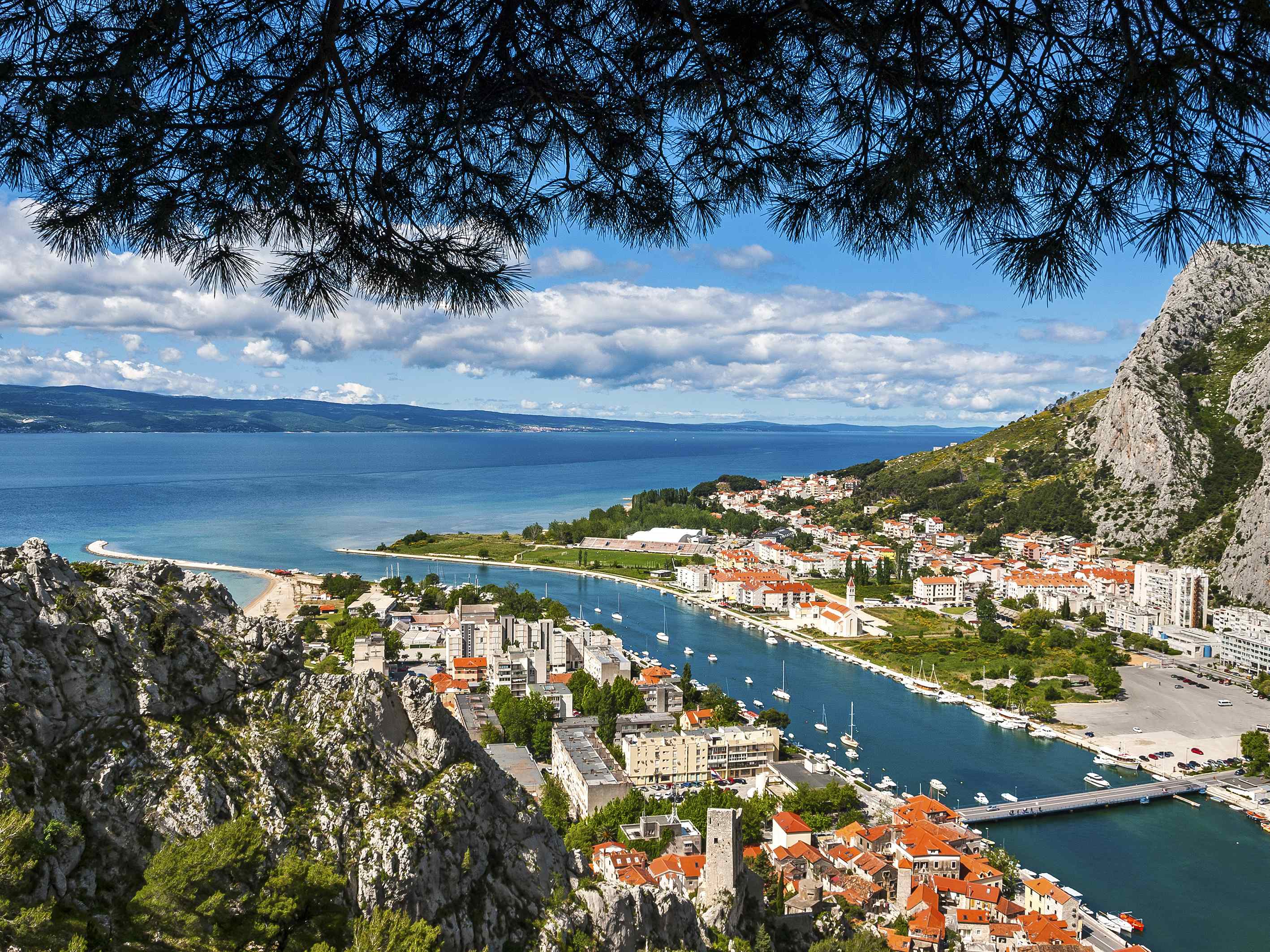 The Cetina river is the largest to flow into the Adriatic in Croatia and helps give Omis a truly unique offer © Omis Tourist Board
The Cetina river is the largest to flow into the Adriatic in Croatia and helps give Omis a truly unique offer © Omis Tourist Board
Omis has been inhabited since at least Roman times. Today, the winding, narrow streets of its Old Town are a pretty promenade with a distinctly Mediterranean atmosphere. Walking down these stone-paved pathways, intriguing architecture built over centuries is revealed – an unexpected city square opens up, seating drinkers and diners. Above them, the walls of an ancient church and beyond, the spectacularly lit Mirabella fortress that stands impressively above the town. You can easily walk to the top and look over the Old Town and river or, by day, take the path further back, up to the 15th century Starigrad Fortress. Its walls are renowned to hold one of the greatest views in Croatia, the island of Brac dominating the skyline, further still, the island of Hvar. Both can be toured by boat on day trips when you visit Omis.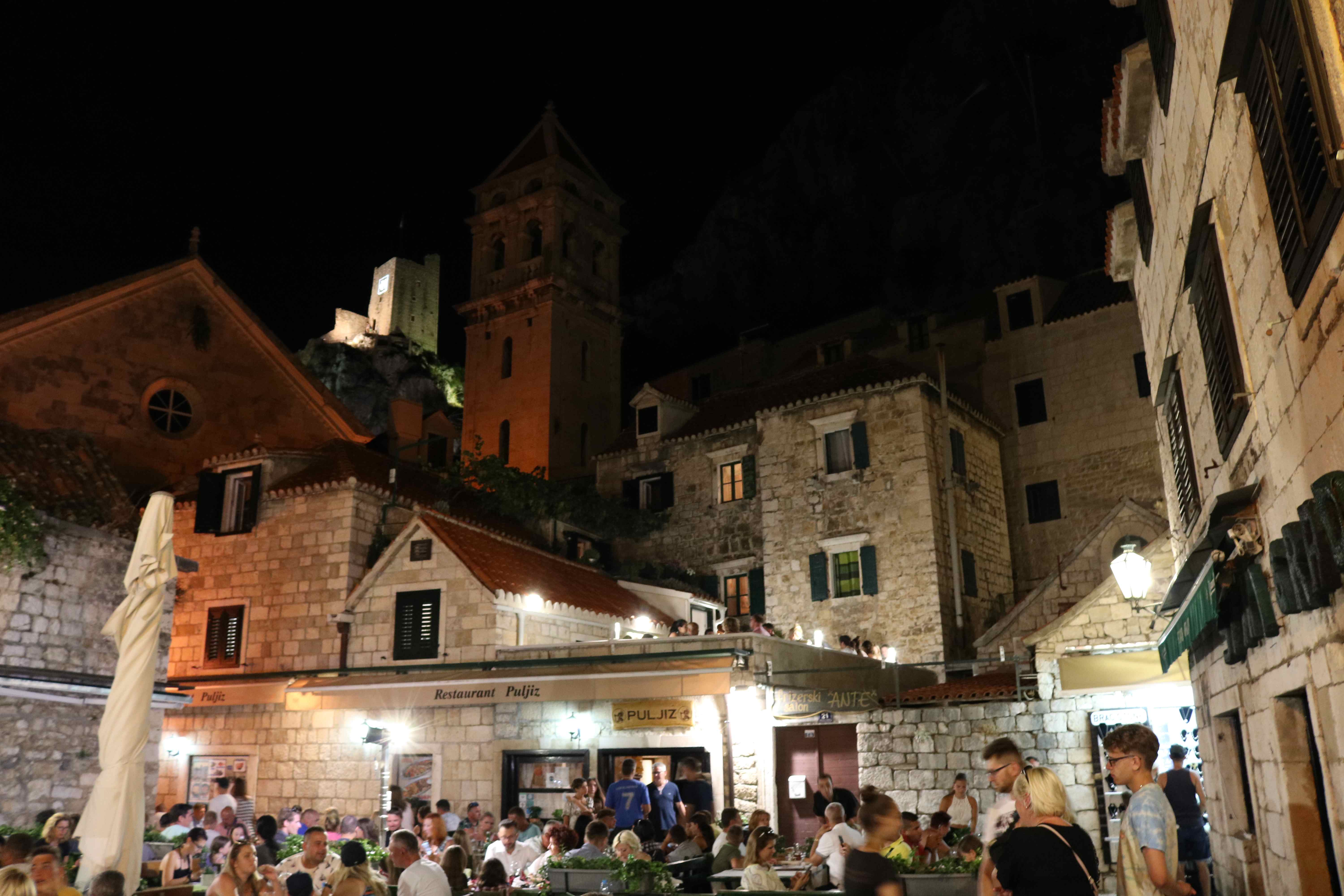 The atmosphere-filled Old Town of Omis © Marc Rowlands
The atmosphere-filled Old Town of Omis © Marc Rowlands
Besides venturing out to sea by boat, taking to the waters of the Cetina river is the best way to get the most from the unique offer when you visit Omis. You can kayak from the town into the nearest sections, watching as the pastel shades of Omis buildings are replaced by the towering, epic cliffs of grey karst rock, sometimes dotted with brave and experienced free climbers. Then, suddenly, the river widens to become flanked by reeds, then fields and trees. Birds sit atop the water or fly overhead, fish dart below you in crystal-clear waters, insects and frogs can be heard coming from some hidden place. The whole landscape seems alive, yet silent except for the sounds of nature – you can't hear a single car engine, not the buzz of an overhead cable, only the dipping of your oar in the calm waters.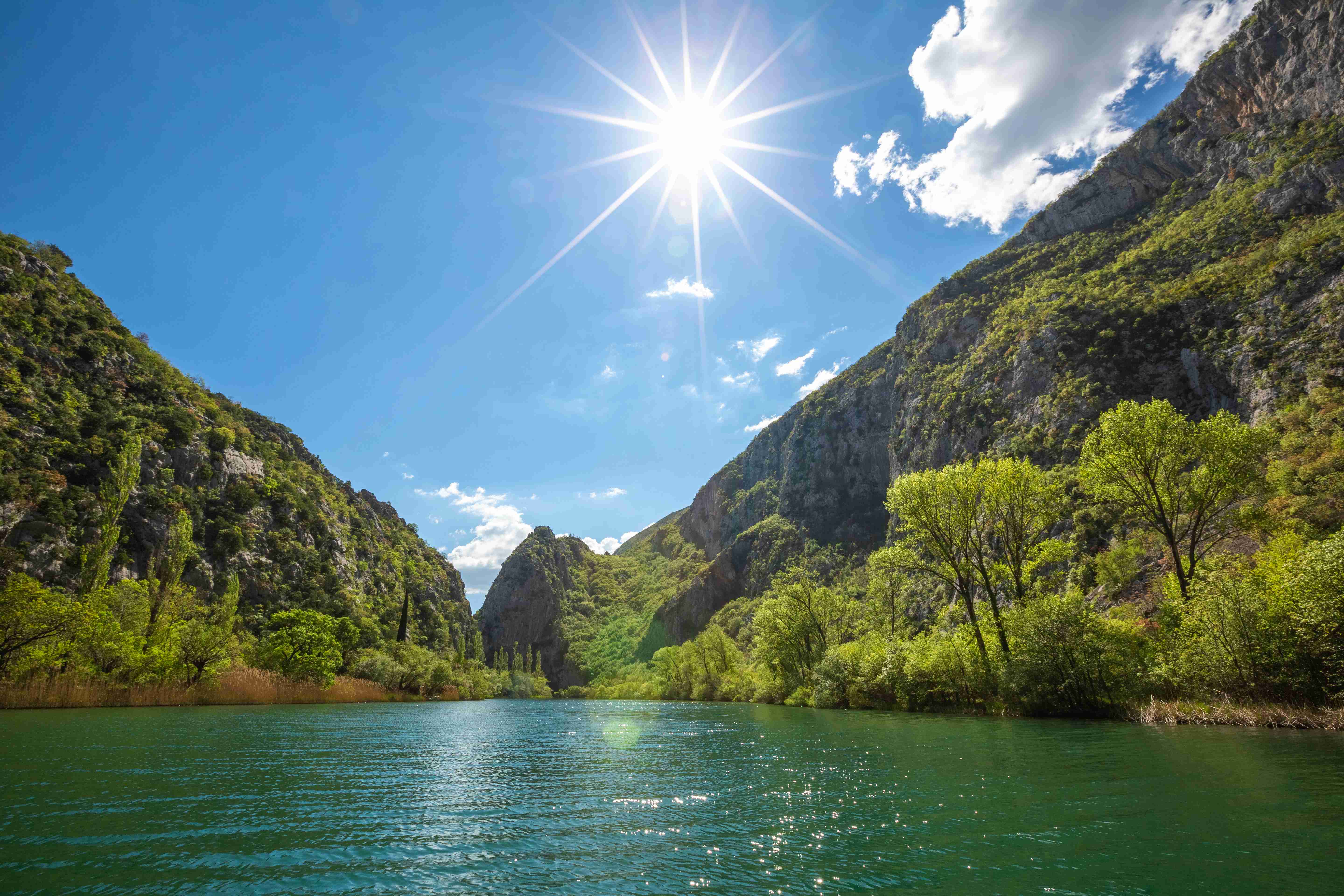 The still and silent Cetina river valley near Omis, perfect for kayaking and reconnecting with nature © Samir Kurtagić / Omis Tourist Board
The still and silent Cetina river valley near Omis, perfect for kayaking and reconnecting with nature © Samir Kurtagić / Omis Tourist Board
Further up the river, the sounds are not so silent. Thrillseekers scream as they fly down the longest run of ziplines in Croatia – a series of eight lines, at times rising 150 metres above the river, the scenery of mountains and surging river is breathtaking, as feet whistle over high treetops. Further up the river, rapids produce white waters perfect for rafting. Although an action-packed run of over two-hours duration, it's an undemanding course taken by many families with children as young as six. Between the fast-moving sections are waterfalls that spray the air and peaceful pools where you pause to swim. At one of the largest stands a huge picnic area, serviced by a restaurant specialising in the rustic cuisine of this part of the Dalmatian hinterland. Thick-crusted, homemade bread is made within metal bells atop wood fires, the perfect accompaniment to local cheeses, prosciutto and seafood.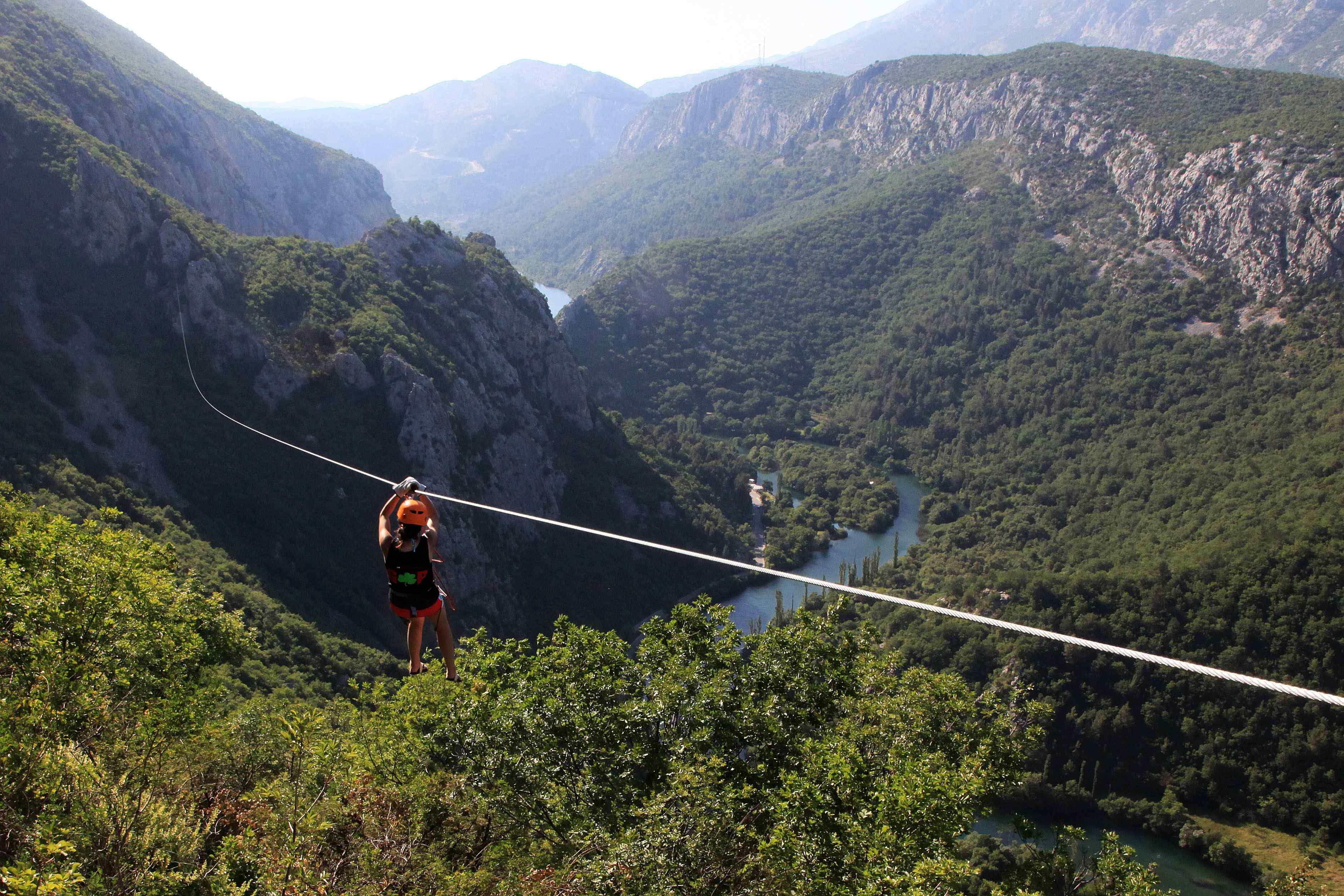 © Zipline Croatia
© Zipline Croatia
Here, away from the shoreline of the town, countless small villages appear on the roads between the river and mountains. Life in these villages looks remarkably like it did a few hundred years ago. The same fruits and vegetables and vines still grow around the traditional houses, many of them ending up on the tables of the fine restaurants you'll dine in when you visit Omis. The same meals are prepared, such as Soparnik, one of Croatia's most authentic dishes – you can only find it in the small region surrounding Omis. The same folk dances are preserved, and the same songs fill the air. You can hear many of them in Omis itself – the city hosts a famous 55-year-old festival of klapa (acapella) music, its singers dressed in traditional clothes, their voices echoing around the stone streets of the Old Town in the same way they have for hundreds of years. The chamber music evenings and one of the most important guitar festivals in the region add to the wonderful entertainment and atmosphere of balmy summer evenings you have when you visit Omis. Soparnik, one of the most authentically Croatian foods in the country. It comes from the hinterland behind Omis and it's unlikely you'll find it anywhere else © Marc Rowlands
Soparnik, one of the most authentically Croatian foods in the country. It comes from the hinterland behind Omis and it's unlikely you'll find it anywhere else © Marc Rowlands The 55-year-old festival of klapa music in Omis © Omis Tourist Board
The 55-year-old festival of klapa music in Omis © Omis Tourist Board
Of course, no trip to the Adriatic is complete without time spent on the beach and swimming in the sea. And, when you visit Omis, you're in one of the best places anywhere in Croatia to enjoy it. Relatively undiscovered, the Omis riviera has a wide range of options to suit all. Want to stay close to town? Visit Omis city beach – it's right on your doorstep, popular with families and its waters famously clean. It is extremely rare to find a huge sandy beach like this, right in the heart of the city.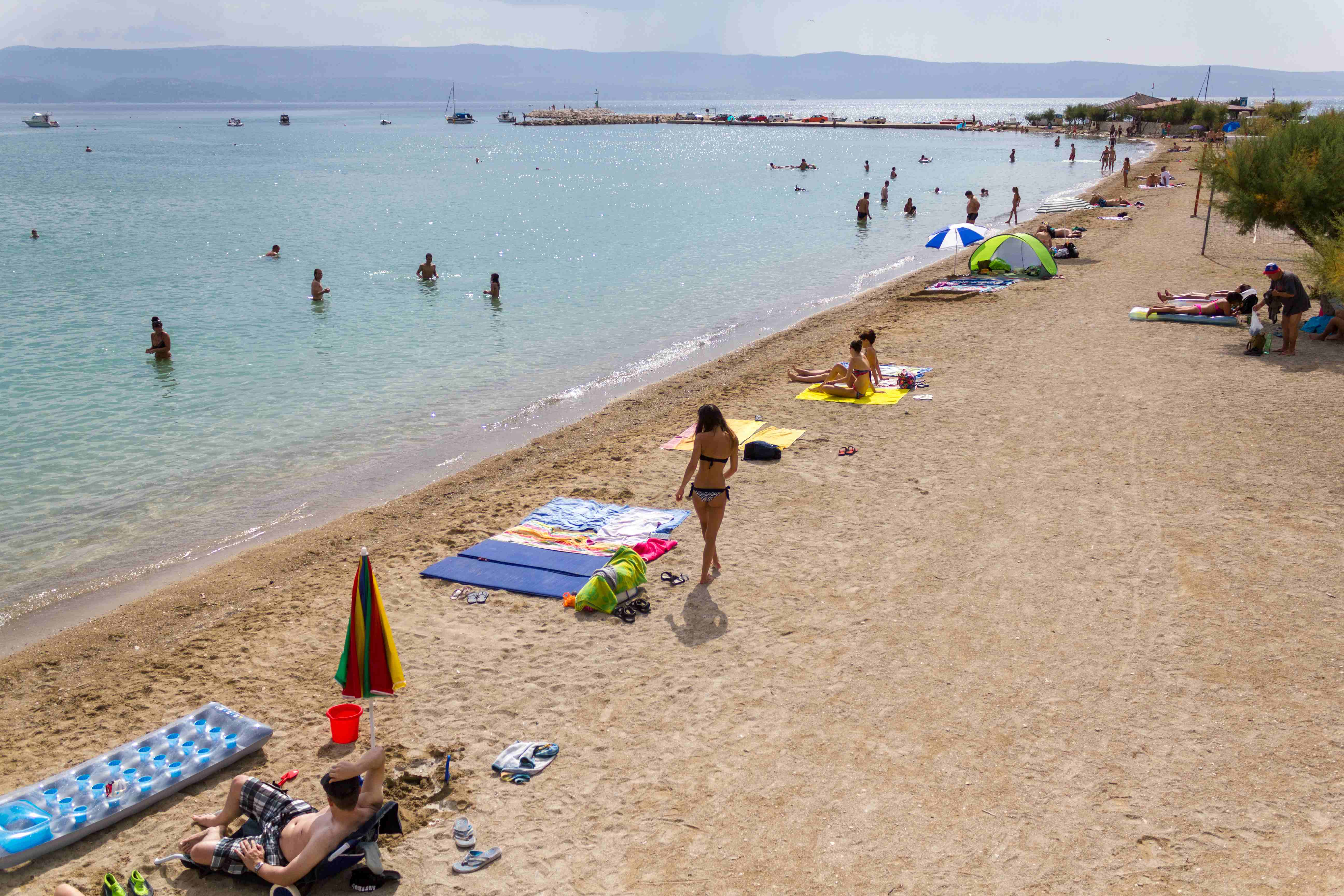 Omis city beach, a huge stretch of sand, moments walk from the centre - there's plenty of room for everyone © Omis Tourist Board
Omis city beach, a huge stretch of sand, moments walk from the centre - there's plenty of room for everyone © Omis Tourist Board
A short ride down the coast offers a 20-kilometre stretch of perfect small-pebble beaches, shaded by scented pine trees, sitting on impossibly clear waters. Pretty hamlets and fishing villages like Nemira, Stanici, Ruskamen, Lokma Rogoznica, Medici, Mimice, Marusici and Pisak allow you to chose between peaceful seclusion, diving and watersports or flavour-packed lunchtime dining in a traditional Dalmatian tavern.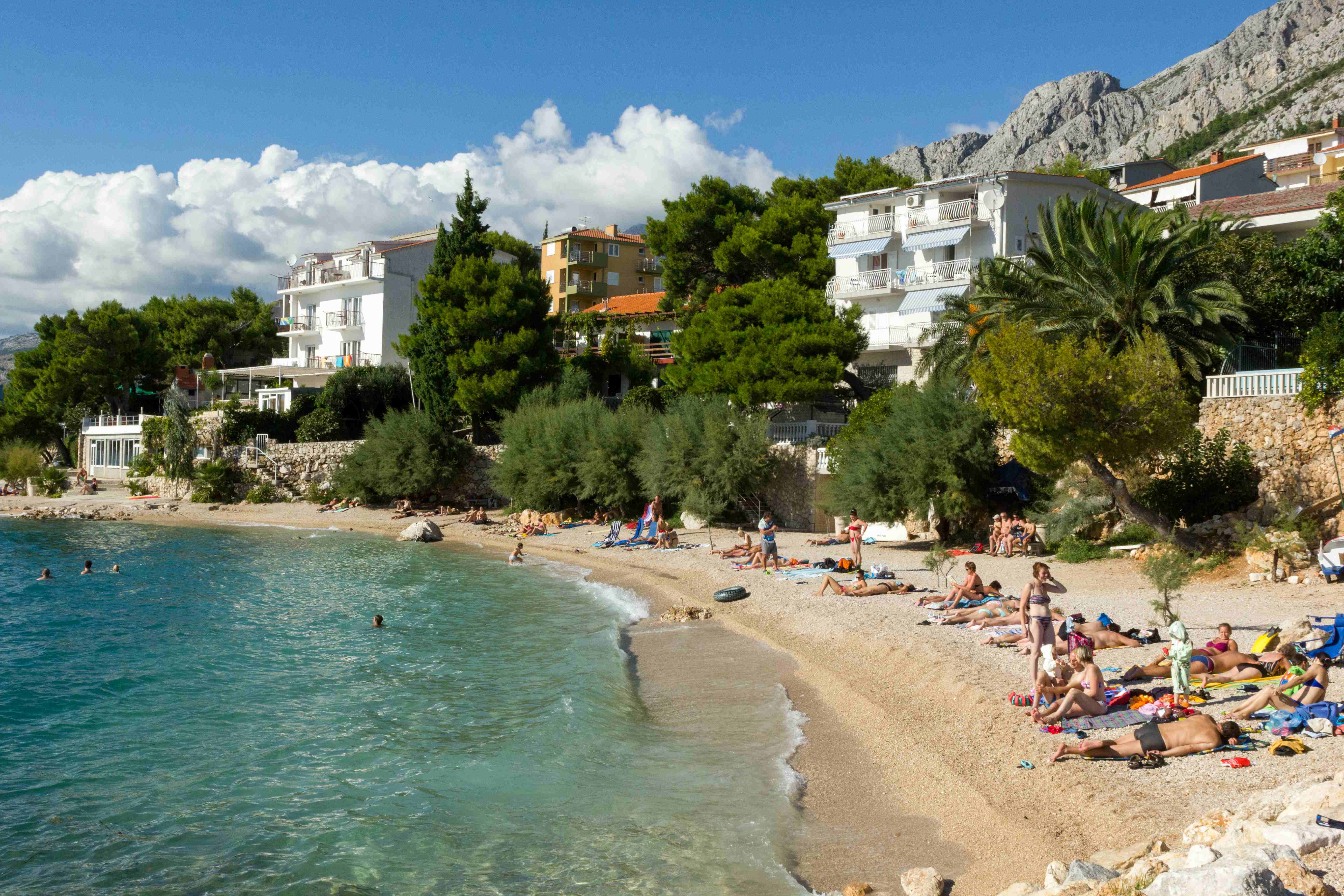 The village of Nemira, one of the countless pristine beaches along the 20 kilometres of the Omis riviera © Omis Tourist Board
The village of Nemira, one of the countless pristine beaches along the 20 kilometres of the Omis riviera © Omis Tourist Board
This winter has long to go. We will be inside for quite some time yet. But, that gives us plenty of time to dream of next summer. Of all the places you think you'd like to be, once the warm days return, the City of Omis and its riviera should be top of the list. Unique in its offer of adventure, nature, culture and heritage, there really is nowhere else like it on the whole of the Adriatic.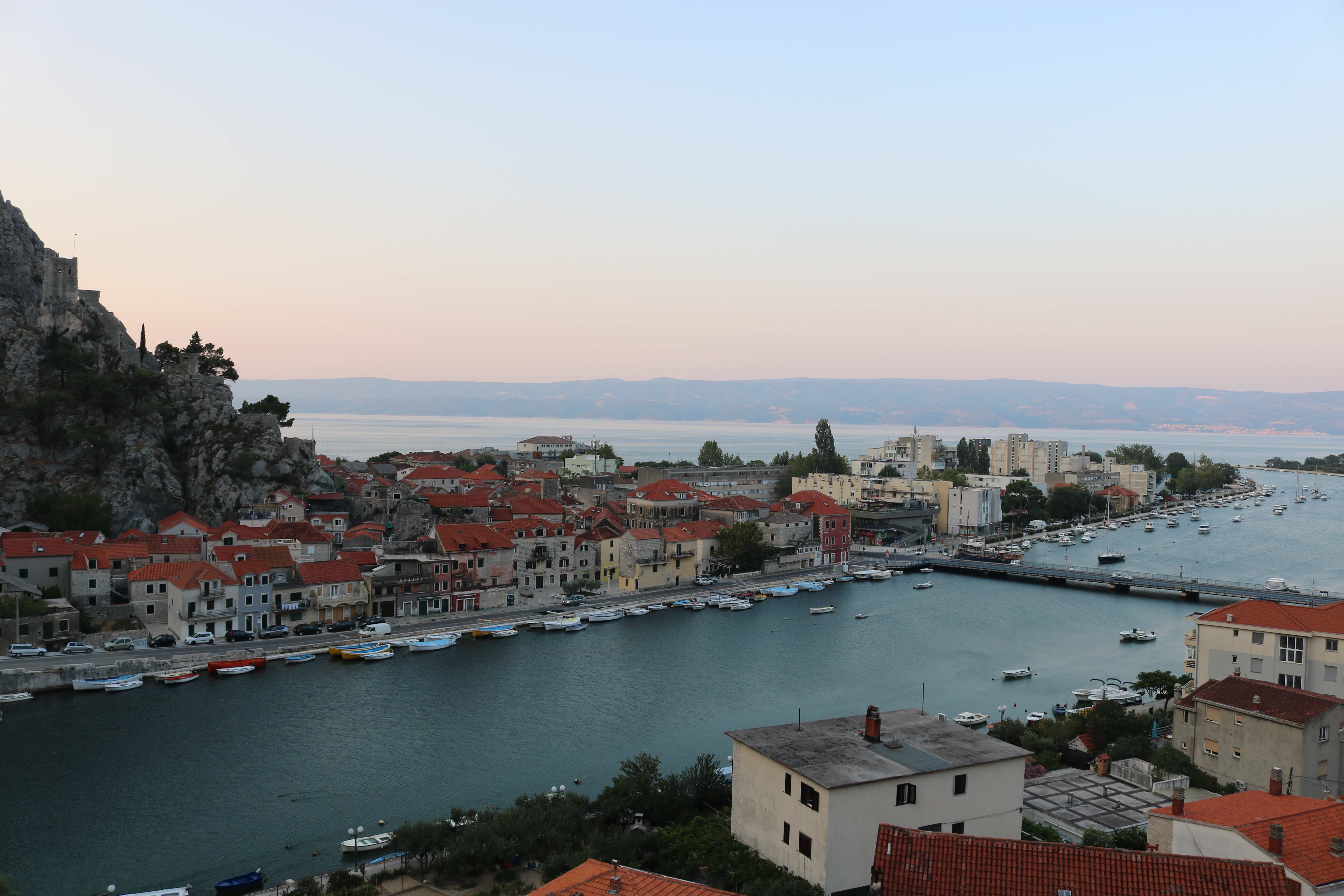 Daybreak over Omis, as seen from the restaurant balcony of Hotel Villa Dvor. The hotel's restaurant is the best place to take coffee in town, the view is spectacular © Marc Rowlands
Daybreak over Omis, as seen from the restaurant balcony of Hotel Villa Dvor. The hotel's restaurant is the best place to take coffee in town, the view is spectacular © Marc Rowlands
This article was written by TCN journalists based on first-hand experience of visiting Omis and was subsequently approved by Omis Tourist Board
Five Things Not to Miss Along Dalmatia's Cetina River
Since back during ancient times, proximity to water meant life, and now even in the 21st century it is still exactly the same. One of the most rich rivers in Croatia is the Cetina river, found in the rocky Dalmatia region, which breathes life into everything near and surrounding it. Undoubtedly, this 105km long river offers an assortment of benefits to the local population from; powering several hydropower plants, acting as a source of fresh drinking water and being the back one to the growing Croatian family adventure tourism market.
From the water source’s majestic beginnings, at a height of 385 metres in the Dinara mountains to its humble end, emptying into the Adriatic Sea, the Cetina has many personalities to enjoy. In this article, I will tell you a little more about my favourite sections of the river and how to enjoy it safely and with full respect to nature.
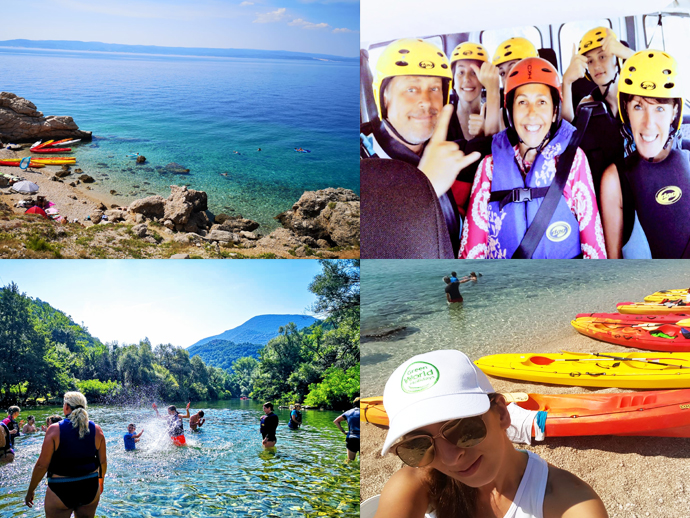
Green World Holidays
River tubing
River tubing is great fun, and not just for adults but also for active families holidaying in Croatia. Sitting in giant inflatable donuts, you’ll have the unique opportunity to descend down small river rapids powered only by your hands and feet. Located slightly north of the village of Kučiće, there is a perfect three-kilometre river section, with many memorable twists and turns. If you want to splash and have fun, and see the Dalmatian hinterland from a very rare perspective, then I can highly recommend this activity when visiting the Cetina river.
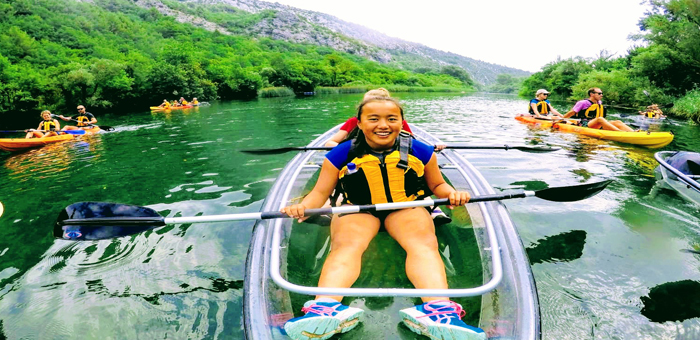
Green World Holidays
Kayaking
All over the world, kayaking is enjoyed as a recreational sport and its particularly popular in Croatia. Our country is blessed with an abundance of pristine rivers, lakes and a stunning coastline, so there are no shortages of places to rent a kayak and enjoy a water adventure. From my experience as a guide, one of the best kayak routes can be found on the Cetina, as the water transcends from sparkling emerald waters to the blue signatures of the Adriatic Sea. This picture postcard perfect route also runs through Omiš, one of the prettiest towns in Dalmatia. Famed for its historical pirates, bringing fear to the whole of the Mediterranean sea throughout the 12th and 13th centuries.

Green World Holidays
Although there are no pirates in Omiš now, I can still guarantee that this is one of the most memorable kayak experiences available. In addition, and unique to the Cetina river, guests can rent see-through kayaks, so as you paddle down the river you can explore the flora and fauna growing along the bottom of the river and enjoy feeling one with the water.
Mini rafting
As a qualified rafting guide for many years, I’ve been fortunate to have experienced the best sides to the Cetina river, and still to this day, one of my favourite activities is mini rafting. Unlike kayaking and river tubing, mini rafting is done on the northern part of the Cetina river, where you’ll find exciting river rapids and challenging waterfalls to descend. Going down the class 2 and 3 rapids (the scale is up to 6) in an inflatable canoe raft is an
adrenaline packed adventure. Along this section of the Cetina, adventurous families will discover one of the prettiest river beaches, called Stružica, which is very popular among the locals.
Professional tours typically conclude in the village of Blato na Cetini and over there you can have lunch in a little restaurant along the bank of the river. This has become a popular tour for family activity holidays in Croatia, allowing parents to better bond and connect with their teenagers, as they steer their own destiny along the Cetina river.
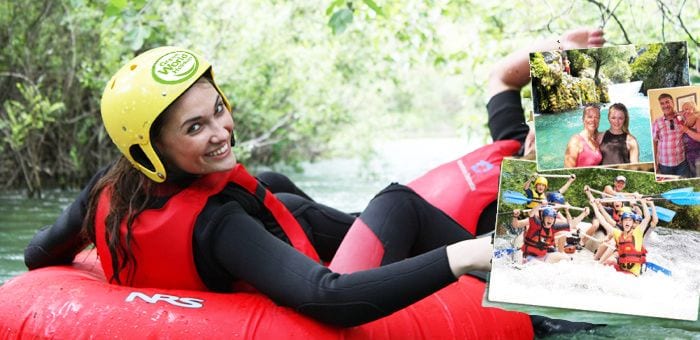
Green World Holidays
Canyoning
Canyoning along the Cetina is an unmissable adventure activity when visiting this Dalmatian region. Expert guides help lead the way and help adventurous guests to plunge into these newly discovered rocky areas and clear waters, providing the most exhilirating and unforgettable experience. It’s a true treat to be able to swim underneath powerful waterfalls, flow down naturally formed chutes, and jump into emerald pools of water. It's more fun than you can imagine and that’s why it's an unmissable experience when visiting anywhere close to the Cetina river.
If you decide to do the extreme version (not for families!) you can abseil down next to one of the highest waterfalls in Croatia, Gubavica (56 metres high). The starting point is in the village of Zadvarje and the finish is next to the oldest power plant on the Cetina river, called Kraljevac. Unlike white water rafting, canyoning is ungraded. So before booking with any sports agency, ask the right questions and discuss what you can expect with the experience. Remember, no canyon is the same!

Green World Holidays
White water rafting
White water rafting is the most popular activity on the river Cetina. The route that you pass along this section of the river is about 10 kilometres long and you will face Grade 2 and 3 rapids. The starting point is north of the village of Kučiće and concludes next to one of the most famous restaurants in Dalmatia, Radmanove Mlinice. On the river, there are a lot of agencies that provide eight-man rafting tours.
Active and sustainable tourism
I hope this article has inspired you to explore the river Cetina and please remember to respect nature. We only have a future if we look after our planet now and give back to the environment and local communities. To try these activities with an Eco-friendly travel company, then contact – Green World Holidays –– a company that believes in sustainable tourism to create wonderful family activity holidays in Croatia. See their INSTAGRAM STORIES – www.instagram.com/

Green World Holidays
Follow our dedicated lifestyle and travel pages for more. If it's just inland Dalmatia you're interested in, give Total Inland Dalmatia a follow.
VIDEO: Drone Footage of the Cetina Like You've Never Seen Before
YouTube channel EdoStuff published a video on their YouTube channel on October 2, 2016 showing drone footage of the Cetina river spring Glavaš lake, the largest source of the Cetina river.
The Race on the Cetina River is Finally This Weekend!
The race on the Cetina river, which had been postponed, will take place this weekend on Sunday, July 31. The event will take place from 15h-19h.
The Race on the Cetina Has Been Postponed!
The race on the Cetina river, which was meant to take place tomorrow, July 17 has been postponed.


